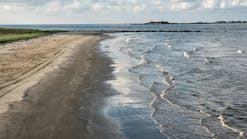As Portland, Ore.’s $1.4 billion Big Pipe Project reaches its tenth year in operation, the city’s Department of Environmental Services recently launched an online gauge that lets the public track in near real-time how the system keeps sewage out of the Willamette River. In the rare occasions when an overflow occurs, the gauge also allows the public to track an incident’s start, stop, and duration.
The Big Pipe Project is shorthand for an ambitious set of actions and improvements, including two giant pipes that line the east and west banks of the Willamette River in Portland, that together eliminated most combined sewer overflows, or CSOs.
For the anniversary, Environmental Services also released ten years of data showing how the project is achieving its original design goals of reducing overflows by 94 percent, making combined sewer overflows to the Willamette River rarer, shorter in duration, and lower in volume. The payoff, since project completion in 2011, is a healthier, cleaner river.
“On this ten-year milestone, I am pleased to bring a new tool for transparency – a way for the public to see how the system works in close to real time,” said Commissioner Mingus Mapps. “The Big Pipe is making a big difference for Portlanders and our relationship to the Willamette River. River recreation has soared as more people are boating, playing, swimming and enjoying the river, and for good reason – the river is cleaner.”
“Overflows are now dramatically fewer, shorter, and smaller,” said Environmental Services Director Michael Jordan. “Ten years of data show how Portlanders’ investment in the Big Pipe system is working. The new Big Pipe Tracker shows the system in action, so keep refreshing your browser during rainstorms and see how the city is sending sewage to the plant and keeping it out of the river we love.”
The gauge, named the Big Pipe Tracker, shows a circular graphic with markers from zero to 100 percent, representing the levels of sewage and stormwater that fill two giant pipes on both sides of the Willamette River. Instead of overflowing to the river, treatment plant operators store, monitor and direct the flow to the City’s main wastewater treatment plant in North Portland.
An accompanying chart tracks flows during a 72-hour period. Data are updated every 15 minutes, with up to a 45-minute time delay. In the rare event that the pipes exceed capacity and an overflow occurs, Environmental Services will issue an advisory.
Environmental Services’ ten years of data shows how rare those occurrences are, and that incidents are fewer, shorter, and smaller in volume. Before the project completion in 2011, it didn’t take much rain to cause an overflow—only about one-tenth of an inch, which is a regular day of rain in Portland. Today, it takes about ten times that amount of rain to come close to reaching an overflow.
While the Big Pipe system is named after its main features—the two giant pipes on either side of the river and one along the slough—the $1.4 billion project that spanned 20 years to build included many other engineering upgrades and additions. Those include green street planters and rain gardens, which continue to be installed today, and a Clean River Rewards program that continues to encourage homeowners to disconnect downspouts and let rainwater soak into the ground instead of adding volume to pipes.






